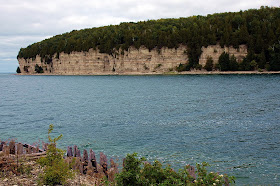Our first attempt to see Fiborn Quarry was over the Fourth of July
weekend (2017). Fiborn Quarry Road is a narrow gravel road with
standing water filling the ditches on both sides of the road. After
about a half mile, we begin to see the road is becoming dotted with
large pot holes filled with water. We manage to drive around a large
number of them until we came to a flooded stretch crossing the entire
road. Since we are unfamiliar with what might lie ahead, we decide
the current road conditions may become impassable for our regular car
to negotiate without the fear of getting stuck. The rainy summer has
also brought out the insects – lots of them. Taking all things
into consideration (including the possibility of encountering a
logging truck), we determine this might be a better adventure for us
to do during the fall months.
Fast forward three months later … We spend the night at the Birch
Lodge Inn (a Michigan Historic Site near the town of Trout Lake in
Michigan’s Upper Peninsula). After breakfast, we head to Fiborn
Quarry. From the Lodge’s driveway on H-40, it is seven miles to
Fiborn Quarry Road.
I am happy to see the gravel road is dry - far better road condition
than it was during our early July visit. In about 8/10's of a mile,
we see the brown Michigan Karst Conservancy sign. At this point,
the road makes a sharp right curve.
Sign
We drive approximately one mile to a small parking lot on the left
side of the road. There is supposed to be a pavilion with a kiosk
about the history of Fiborn Quarry (1905-1936) and the beginning of
the 1.5 mile trail to the ruins. We don’t see it. Later, I find
out we should have driven a little farther down the road to reach
that point. In the meantime, I have a little history about the
quarry from some Internet research.
According to the Michigan Karst Conservancy website, “The
Michigan Karst Conservancy purchased this 480-acre property in 1987
and established the Fiborn Karst Preserve, managing it as a natural
area open to the public under guidelines meant to prevent damage to
natural features, vandalism and unsupervised, unsafe cave
exploration. A small town grew up next to the quarry, which
included an elementary school, a boarding house, a company store and
housing for employees and their families.
Fiborn
Karst Preserve features two self-guided trails highlighting natural
and historic features.
The
Sinkhole Trail is a short loop past many shallow sinkholes and a
creek disappearing below ground. The 1.5-mile Barbara Ann Patrie
Memorial Trail travels along the edge of the quarry, through
second-growth forest and past sinks, and Fiborn Pond.”
At this little parking lot there is an old road with a gated
entrance. There are some people here that just finished their walk.
They tell us this road will take us to the mining ruins. We walk
around the gate and begin our easy half mile walk down the leafless
tree-lined road toward this historic site.
Road to Ruins
To our left is the quarry floor. Its gray rocky landscape reminds me
of a moonscape. On our right is a limestone wall bathed in golden
light from the late afternoon sun. Soon we see Fiborn Pond to our
left. That means we are near the ruins.
Quarry Floor
Limestone Wall
Fiborn Pond
Here’s the bad news - we have about an hour of daylight. The good
news is - we will have the "ghost town" all to ourselves.
So, we can enjoy the silence while we walk around the abandoned
ruins.
We see the first building at Fiborn Quarry. It was used to sort and
load the ore into the railroad cars.
Ore Sorting & Loading Building
Inside the Ore Sorting & Loading Building
Next, we go over to the large building where they stored and repaired
the locomotives. Like the sign says – these are historic buildings
please treat them with respect. You know the saying “take only
pictures, leave only footprints”. The sunlight and shadows make
for some interesting photo opportunities.
Locomotive Shed/Repair Shop
Sign
Light & Shadows Inside Building
The last building we see is the Powerhouse.
Dry Cracked Ground near Power House
Ruins of Power House
Power House Wall
Shadows on Wall
The sun is sinking lower in the western sky when we notice the nearly
full moon is already riding high in the early evening sky. That's
our cue to hike back to the car.
If you are interested in other Michigan ghost tows, I invite you to
view my blog posts by clicking on the following links:
Since opinions, preferences, and budgets vary, I recommend checking a
trusted travel source for current reviews on food and lodging.
Family vacations created some of my favorite memories. Start
planning your next memorable trip today.




















































